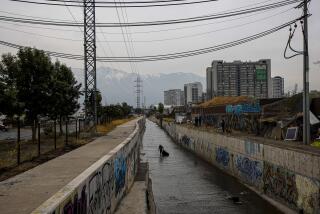Chile Setting Economic Pace South of Border : Latin America: Brazil remains a major disappointment. But elsewhere, fiscal and other reforms appear to be paying off in the ‘90s.
- Share via
SANTIAGO, Chile — Inflation is down. Investment is up. Exports are growing. And Latin America is well on its way to making the 1990s a decade of solid economic expansion.
Leading the charge is Chile, where a booming economy grew by an estimated 9.5% in 1992. Five other countries achieved vigorous growth rates of 6% to 8%.
The big disappointment was Brazil, where Latin America’s largest economy shrank last year amid an unfavorable climate of political uncertainty and inflation of more than 1,000% a year.
Despite Brazil, hopes for Latin American development are high. In country after country, years of fiscal, monetary and market reforms appear to be paying off.
The region’s rising potential has caught the attention of many international observers, including President-elect Bill Clinton.
“I think that a major part of our economic future rests in building up strong two-way trade with Latin America,” Clinton commented recently.
Gert Rosenthal, executive secretary of the U.N. Economic Commission for Latin America and the Caribbean, agreed that the region has great potential as a U.S. trading partner, especially if plans for free trade in the hemisphere become law.
“At any rate, it’s a market of 450 million people of middle income, which is not insignificant,” Rosenthal said in an interview this month. He ticked off some recent developments that help to give Latin America a solid base for continued growth:
* The quality of macro-economic management has improved in all of the region’s countries.
* Exports have diversified, making countries less dependent on one or two basic commodities.
* Small- and medium-size companies are innovating and competing more successfully.
* Banking and financial systems have been modernized in most countries, helping to marshal and channel resources.
While progress is much slower in some countries than others, “they’re all moving in the same direction,” Rosenthal said.
And while overall regional growth still does not match lush levels of the 1960s and ‘70s, it certainly beats economic drought years of the 1980s.
“Everything that’s happening so far points in the direction of a much more favorable climate in the 1990s,” Rosenthal concluded.
The unfavorable climate of the 1980s came partly from Latin America’s foreign debt crisis. The region still owes $450 billion to foreign creditors, but lower interest rates and renegotiated terms of payment have greatly eased the burden, according to a year-end economic report by Rosenthal’s Santiago-based U.N. commission, known as ECLAC.
It said the ratio of due interest payments to export income declined for the sixth straight year and now stands at one to five, the lowest ratio since 1980. That has helped reorder government finances across the region.
And fiscal belt-tightening by most of the countries in recent years has contributed not only to reducing inflation but to increasing private-sector confidence in government economic policy.
According to ECLAC estimates, the region’s gross production grew by 2.4% in 1992, compared to 3.5% in 1991 and 0.3% in 1990. Argentina, Chile, Panama, the Dominican Republic, Uruguay and Venezuela all had growth rates of more than 6% in 1992, while Barbados, Brazil, Peru and Haiti had negative rates.
Leaving giant Brazil’s poor performance aside, the rest of the region’s economies expanded by 4.3%. That growth is notable not only because it coincided with successful efforts to bring down inflation, but also because it came “in a generally recessive or uncertain international context,” the report said.
Regional inflation--also without counting Brazil’s--was down to an average of 22% in 1992 from 49% in 1991, according to ECLAC. (But with Brazil’s inflation of 1,130% included, the regional rate was 410%; it was 1,185% in 1990.)
Latin American and Caribbean exports grew by an estimated 4% during the year to a total of about $126 billion. Despite its other problems, Brazil’s exports grew by nearly 15% and accounted for $35.6 billion of the regional total.
Regional imports grew by 18% in 1992 to a total of $132 billion, proving Latin America’s growing potential as a market for international commerce. Mexico increased its imports by $8 billion, Argentina by $5.7 billion, Venezuela by $2.6 billion and Chile by $1.8 billion.
U.S. products account for more than half of total regional imports.
The import boom turned a 1991 regional trade surplus into a 1992 deficit of more than $6 billion. Despite that drain on foreign exchange, Latin America continued to maintain a surplus in the flow of financial resources, bringing in $57 billion more than it paid out, ECLAC calculated.
It said high interest rates in the region, privatization of government companies, lucrative returns on investments, and growing economic stability all helped attract funds from abroad.
While the rush of foreign capital helped finance economic growth, total investment in most countries of the region remained below levels needed for the kind of accelerated expansion that could overcome widespread poverty, the U.N.’s Rosenthal said.
“Progress is not advancing rapidly enough,” he said.
A notable exception is Chile, where years of free-market policies and economic stability have nurtured an export-led private sector that sets an example for the rest of the region. Since 1981, Chile’s economy has grown by 53%, and urban unemployment has dropped from 18.5% in 1984 to between 5% and 6% in 1992.
Brazil’s economy, in contrast, has made no net gain since 1987. Political uncertainty and erratic economic policies have failed to control rampant inflation. Fortunately, Rosenthal said, Brazil is an exception in the Latin American trend. “I think the region is moving in the general direction of Chile,” he said.
An October report by the Inter-American Development Bank confirmed the trend but added a warning:
“It is clear that the economic and financial policy reforms put in place will not last, nor will political stability be achieved or maintained, if explicit and urgent attention is not directed to the region’s immense and long-neglected problems of poverty and social sector disrepair.
“A further deterioration of the already highly uneven income distribution in most of the countries in the region could effectively block recovery by creating political and social unrest, reducing private inflows and turning domestic saving outward again.”
More to Read
Sign up for Essential California
The most important California stories and recommendations in your inbox every morning.
You may occasionally receive promotional content from the Los Angeles Times.











